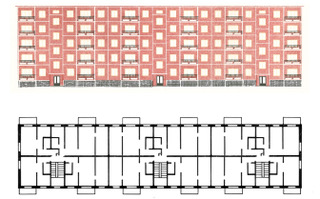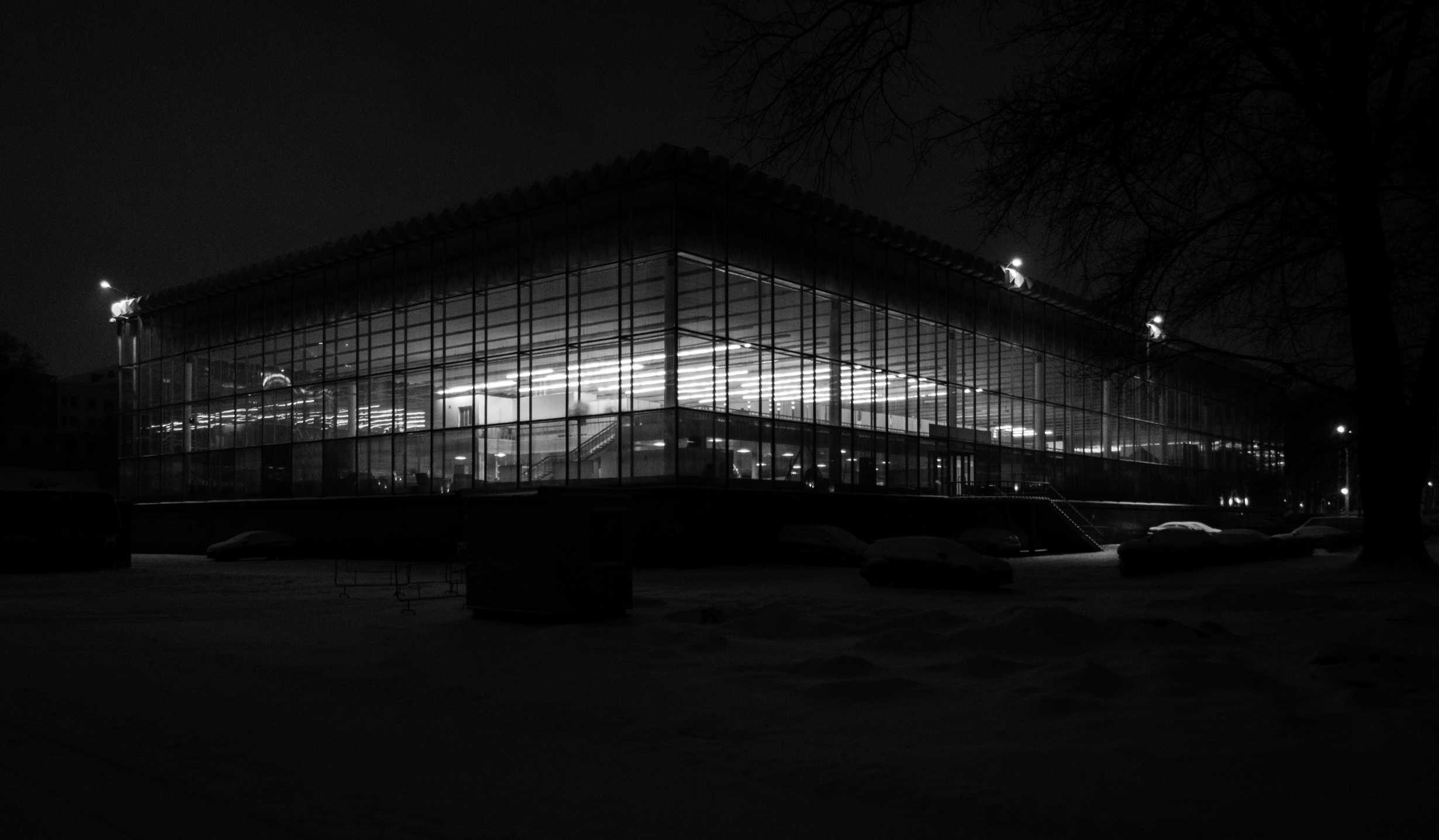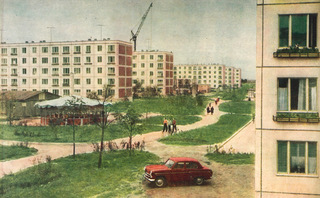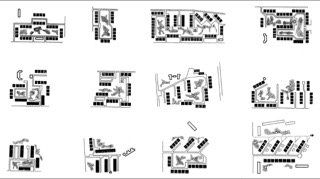
For those who suffered the consequences of Yalta’s division of Europe, the Helsinki Final Act brought grounds for optimism. Today, as Russia’s regressive war on Ukraine reopens old conflicts, it stands as a monument to European modernity.
The functionalist housing built across the USSR in the 1960s is one relic of the past that is here to stay. Architects must take an interest in these increasingly decrepit buildings, which despite lack of architectural merit are popular with residents.
For a few years now, late-Soviet architecture has been the order of the day. After constructivism, which has served as inspiration for numerous contemporary star architects since they were young, and Stalinist Empire style, introduced into western discourse by Boris Groys in the 1980s, today the focus is shifting to the architectural heritage of the second half of the USSR’s existence. Spanning the period from 1955 to 1991, this is known as post-war Soviet modernism.
What is notable about the new wave is the interest in unique buildings. Having started with the primary monuments, the search then descends to the secondary level, from the centre to the periphery. In the last few years, the architecture of the former national republics has come under close scrutiny.1 Deeper probing might sound sensible, but this approach is something of a blind alley – the ‘cream’ of the architecture of this period is very thin. There are only a few masterpieces amidst the jungle of standard housing and anonymous construction.

Image: Dimitrij Zadorin
The fewer impressive examples of this architecture there are, the more impressive is the sheer scale of its bulk. Whole cities seem to stem from the same design desk. This is especially true of the construction that took place during the first half of the 1960s, when the infatuation with standardisation neared its climax. In 1963, 95 per cent of all residential construction followed standard designs. This was not very different for public buildings – schools, grocery stores, cinemas. Even when, in the rare cases, unique schemes were used, they still followed carefully predefined models. Completely obsessed with effective use, devoid of decoration, these structures represent the functionalist period of Soviet architecture.
The situation started to change after 1969, when the Communist Party and the Council of Ministers of the USSR issued a decree stipulating a transition from quantity to quality in construction. For mass housing, these arrangements meant using any means possible in order to introduce variation in the layout of standard estates. Architectural design became keen on monumentality. Much attention was paid to the reconstruction of city centres, resulting in impressive ensembles. Large streets regained importance as showcases of Soviet life. The conditions were thereby created for the unique architecture that we call Soviet modernism.
Against the background of this monumentalism, architectural production pre-1970 faded. Late-Soviet critics were quick to point out its deficiencies. The official interpretation of the functionalist period from 1987 held that ‘The tendency to create simple, laconic structures, in which form followed function, caused even objects built to individual designs to obtain features of standardised, impersonal architecture. Nevertheless, in the best works of the time, the expressivity of architectural form was at a high level.’2 But to find itself among the ‘best works of the time’ was indeed a hard task for a building to accomplish. Those that failed were denigrated and deemed outdated ‘even before completion’.

The VDNKh in Minsk. Image: Dimitrij Zadorin
Such was the case with the glass box (a popular template during the 1960s) of the VDNKh exhibition centre in Minsk, completed in 1968. Yet, when the city decided to demolish the building at the end of 2016, the progressive community expressed alarm. Suddenly, it turned out that the Exhibition Centre was not only great architecture, but a true symbol of the era, whose heritage can easily be damaged or even lost. Here, the paucity of exceptional functionalist architecture turned out to be helpful. Architect Galina Levina, a daughter of one of the architects of the building, claimed that ‘memory is a chain. If some of the links fall out, misunderstandings and conjectures about history arise. If such architecture is cleansed from the visual perception of Minsk, we will think of the 1960s as an era of prefabricated concrete slabs, standardised architecture. And this is not so.’3 Ultimately, attempts to save the building proved futile. In April 2017, in the course of just two weeks, it was turned into a pile of debris. But those who care learned a lesson: today, there is a movement on the rise to prevent other modernist buildings facing a similar dismal end. The architectural elite is now appealing to the broader population in order to protect urban heritage from the virus of ideological and aesthetic hostility towards modernism, and its functionalist decade in particular.
For standard housing, however, there seems to be little hope. Its architectural qualities are admittedly low: nobody is going to stand up for it. And the argument that Khrushchev’s policy was the only way of solving the urgent housing problem in the country does not help, stressing as it does the temporariness of the justification.
However, practice has shown that standard residential estates do get support as soon as they come under threat of damage or demolition. Suddenly, it becomes clear that the modernist habitat has its own distinct qualities – human scale, greenery, decent social infrastructure, location. Since 1991, urban infill has become a scourge of that idyll. In former Soviet cities, there have been countless cases where the unbuilt space of the estates has been filled with new high-rise development. This provokes indignation from local residents, who worry about the loss of green areas, noise, rubbish and the burden upon infrastructure such as social amenities and public transport.

Image: Dimitrij Zadorin
Even more telling is the situation around the reconstruction of mass housing from the late 1950s to the mid 1960s in Moscow. The program for a gradual substitution of shabby five-storey residential buildings with new standard blocks was conceived before the collapse of the USSR, but took place mainly during the 2000s.4 A triple increase in the density of construction as the result of a larger number of stories allowed developers not only to resettle tenants from the old buildings but also to gain profit from selling remaining flats. This program, which due to the crisis of 2010s has dragged on until today, originally planned to demolish only buildings that had been defined as unsuitable for modernisation. In the spring of 2017, however, the mayor of Moscow, Sergey Sobyanin, decided to greatly expand the reconstruction program to cover all five-storey developments from the functionalist period in the city.5 Since the remaining housing stock of this kind is about four times larger than what has been already demolished,6 the realisation of the proposal cannot but last several decades. With this in mind, it is tempting to surmise that there is a different logic behind the initiative than the official claim to provide Muscovites with better dwellings. A likely scenario is that the renovation of the estates will proceed in the way suggested by developers, although the authorities have always denied this. Still, the policy caused mass protests in the streets, gathering displeased citizens from all sides. The protests showed that social interests are greater than enmity towards the deficiencies of the standardized environment. Despite its monotony and poor quality, for its residents standardised housing is preferable to what may substitute it.
The appeal to social and cultural aspects when arguing for the preservation of modernist estates of the 1960s is a strategy employed by Kuba Snopek in his book Belyayevo Forever,7 a speculative attempt to find intangible qualities in a standard environment that drastically lacks architecture. Extrapolating qualities from a single standard building to whole residential estates, the author convinces us of their spatial qualities. Yet he is still compelled to use ‘anti-architectural’ means.
The heritage of the functionalist period in Soviet cities is thus embraced from two sides. On the one hand, architects defend unique objects, neglecting standardized development. On the other hand, standardized development is defended by social protest. How effective these approaches will remains to be seen, since awareness of the problems is still very recent. For the time being, however, there is not much to celebrate.
Yet the architectural heritage does stand out here as a quality in itself. More important still are structural conflicts across the former USSR, both regional and between former republics. The common Soviet past is being processed slowly and only with immense effort. The most obvious example is Ukraine, where the de-Sovietisation law is leading to the extirpation of Soviet symbols, including architecture. Clearly, this is a reaction to the present war with Russia. But neither it is calm in Russia itself. The reconstruction program in Moscow does not have analogies in other cities in the country. In most regions, especially in those with a rough climate, the deterioration of mass housing is much greater. If its condition in the capital is problematic, then elsewhere it must be bordering on the catastrophic. When dilapidated buildings start to fall apart, social unrest will be of such an order that the current protests by the permanently disgruntled Muscovites will seem harmless.
The situation is daunting. The gap between architectural interests and problems of the standardised environment reflects a massive failure to grasp the real problems. Bridging that gap may help understand these problems better and even offer the basis for action. That bridge is mass housing. However, the latter must first generate the interest of architects.

Image: Dimitrij Zadorin
Of course, the mass housing of the early 1960s is not attractive: its scale was overwhelming, uniformity reached its limits. National variants were out of the question; the differences in the composition of housing estates were solely the result of climatic peculiarities. The most rapacious was large-panel housing: from 1959 onwards, hundreds of factories for production of the I-4648 construction system spread across the Soviet Union: from pro-European Estonia to neutral Belarus to artificially Soviet Kazakhstan. These factories manufactured identical buildings. Architects had some freedom in arranging housing estates from these standard blocks, but the components of the residential environment and the methods of construction were always the same. As a result, most former Soviet cities, which today represent various ideological worlds, include identical fragments of urban fabric.
And yet, standardised estates have an amazing potential, one rooted precisely in their omnipresence. This makes them intriguing. Nobody is capable of disposing of this environment. The Ukrainian de-Sovietization law may succeed in getting rid of the symbols of the regime, its unique architecture, but it cannot really interfere with Soviet mass housing. Even in Moscow, with its enormous capital, the eradication of the standard environment of the early 1960s is approached with scepticism. There is no need to state that the same heritage in the rest of the former USSR – in fact tens of times larger than in the capital – is living its own life.
Unlike the best architectural works of the time, mass housing is not the mirror of the epoch but its immediate reality. It is an incubator of ‘Soviet man’. This man shaped the environment, and the environment shaped him in response. Up to this day, fifty years later, it is here that Soviet man is reproduced, no matter what impulses there are to renounce any affiliations with the past. The fragments of the identical urban fabric remain the most unifying elements in the ever more fragmented space of the former USSR. It is these fragments that we will have to find and focus on, in order to stay in control of the situation. Without the architect’s attention, this will be impossible.
Of great interest are the projects of the Architekturzentrum Wien: Ritter, Katharina, Ekaterina Shapiro-Obermair, and Alexandra Wachter, eds. Soviet Modernism 1955-1991: Unknown History. Zürich: Park Books, 2012. Print. and of tranzit.at and Goethe Institut ‘The Empire Strikes Back’ that started in the Summer 2016.
Bocharov, Yu., and N. Gulyanitsky. Architecture of the USSR 1917-1987. Moscow: Stroyizdat, 1987. Print. P. 198.
Yudina, Irina. “A yesli vozniknet takaya zhe ‘probka’, kak u tsirka?’ Arkhitektor o snose zdaniya VDNKh na Yanki Kupaly.” Novosti TUT.BY. N.p., 27 Dec. 2016. Web.
The main document of the program, still active today, is the Decree of the Government of Moscow No. 608-PP of 6 July 1999 ‘On the Tasks of Integrated Reconstruction of 5-Storey Development of the First Period of Industrial Housing Construction until 2010’.
The idea to extend the program emerged during the meeting of V. Putin and S. Sobyanin. “The Meeting with the Mayor of Moscow Sergey Sobyanin.” The President of Russia. N.p., 21 Feb. 2017. Web. The elaboration of the law is in an active stage since the protests started.
The program from 1999 was called upon to demolish 6 million square meters of housing. The remaining 5-storey housing stock in Moscow is about 25 million square meters.
Snopek, Kuba. Belyayevo Forever: A Soviet Microrayon on its Way to the UNESCO List. Berlin: DOM Publishers, 2016. Print.
The series 1-464 was by far the most popular large-panel system in the Soviet Union, with about ⅔ share in this method of construction. Yet by 1965 only about a quarter of standard residential blocks were assembled from large panels, yielding greatly in quantity to brick and concrete block systems.
Published 22 September 2017
Original in English
First published by Springerin 3/2017 (German version); Eurozine (English version)
Contributed by Springerin © Dimitrij Zadorin / Springerin / Eurozine
PDF/PRINTSubscribe to know what’s worth thinking about.

For those who suffered the consequences of Yalta’s division of Europe, the Helsinki Final Act brought grounds for optimism. Today, as Russia’s regressive war on Ukraine reopens old conflicts, it stands as a monument to European modernity.

Artist Marharyta Polovinko’s creativity persisted in a tormented form through her experiences as a soldier on the Ukrainian frontline. The words of a recently called-up fellow creative and young family man provide a stark reminder that the Ukrainian military is buying Europeans time.